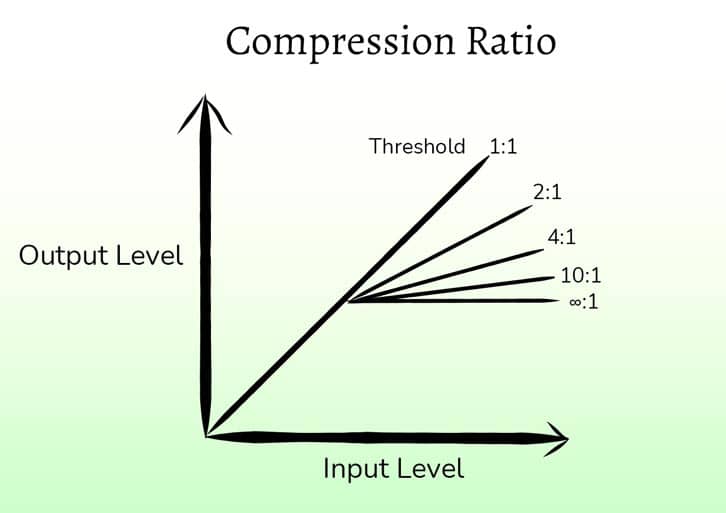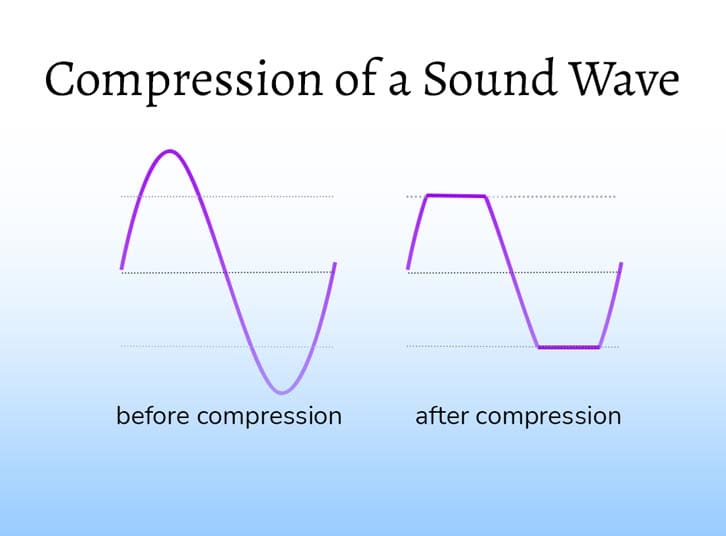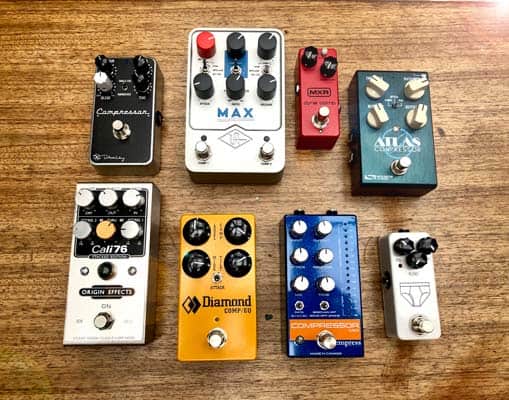Introducing the Compressor Pedal
The compressor pedal, often overlooked by beginner guitarists and bassists, is perhaps the most powerful tool in a pedalboard. The results of a compressor pedal are not always obvious, but when used in the right way, it can do a lot of things for your guitar playing.
So what does a compressor pedal do? In short, a compressor pedal offers direct control of the overall balance in audio output, ensuring a consistent and controlled sound.
For more knowledge about guitar gear, and here for all of our audio equipment reviews.
The Basics of Compression, How It Works
Compression in audio terms refers to the process of reducing the dynamic range of a signal. The dynamic range is the difference between the loudest and quietest parts of an audio signal.
A compressor pedal works by narrowing this range, making the quieter sounds louder and the louder sounds quieter, resulting in a more uniform and balanced output. This process not only enhances the clarity of the sound but also adds a professional polish to the music.
What does A Compressor Pedal Do for Your sound?
When guitarists talk about compressor pedals, you often hear words like ‘indispensable’ or ‘secret sauce’.
Here are a few things a compressor pedal can do for you:
- Be Your Dynamic Glue – A compressor pedal smooths out the intensity and volume peaks that naturally happen when you are switching between rhythm and lead or between fingerpicking and strumming. It’s an easy way to a more polished overall sound.
- Boost Clean Tone – Clean guitar can often get lost in the mix of a band. A compressor pedal can help your signal cut through the mix so you can be heard.
- Bring out Acoustic Guitar, Especially Nylon Strings – Acoustic guitar when amplified can sometimes sound like a lesser version of itself, especially classical guitar and other instruments with nylon strings. A compressor can bring your acoustic sound to life in a stage mix.
- Increase Sustain on Lead – Lead guitar benefits greatly from a compressor pedal as it helps you achieve consistent sustain without distortion, loss of articulation, or adding volume.
- Clean up Your Picking – You might wonder how some guitarists sound so smooth when picking. Yes, good technique is the main culprit, but you can also bet they are using a compressor pedal. A compressor pedal will even out the spikes in your picking.
- Thicken and Warm Up Your Overall Tone – A compressor can be used to sculpt the weight and warmth of your sound.
- Make Bass Playing Easier – Many bassists won’t play without their compressor pedal of choice. In addition to bringing out the lowest bass notes and overall articulation, a compressor pedal can clean up finger noise and give you sustain that makes bass playing a lot easier.
In general, when using a compressor pedal, start with moderate settings and adjust gradually. Pay attention to how it affects the dynamics and tone of your playing. Experiment with different settings to find the sweet spot that complements your playing style and genre.
How to Use a Compressor Pedal
Typical Controls on a Compressor
Threshold
Different compressor pedals refer to the threshold parameter differently. The knob is sometimes labeled ‘sustain’, ‘sensitivity’, or ‘compression’. They all refer to threshold – or how much signal it takes to trigger the compression effect.
The threshold control sets the level at which the compressor starts to engage. When the signal exceeds this set level, compression begins, reducing the volume of the louder parts of the signal.
Ratio
The ratio control determines the degree of compression applied to the signal. It represents the relationship between the input signal level and the output signal level.
A higher ratio (usually starting around 8:1) means more compression giving you a heavier, high-powered sound often used for metal and hard rock sounds. You will have less dynamic range with a high ratio (sometimes referred to as ‘limiting’) and some distortion.

A lower ratio indicates less compression. This results in a greater dynamic range and a more natural, subtle compression sound. Light compression ratios usually fall in the 1.5:1 or 2:1 range.
Output Gain
The Output Gain control on a compressor pedal, often labeled as ‘Gain’ or ‘Level’, adjusts the overall output volume after compression. This feature compensates for the volume reduction caused by the compression process. When the dynamic range is narrowed and louder parts are attenuated, the Output Gain allows you to bring the overall signal back to a desired volume level.
Essentially, this control ensures that the compressed signal maintains its presence in the mix, matching or exceeding the original signal’s volume. It’s crucial for restoring any loudness lost during compression and can also provide an extra boost to the signal.
This parameter can be used creatively to enhance the tone when driving the signal into other effects or the amplifier. The Output Gain is key to achieving a balance between natural dynamics and the compressed sound, ensuring a dynamically consistent and tonally rich output.
Attack
The attack control dictates how quickly the compressor responds once the signal exceeds the threshold. A faster attack time means the compressor engages more quickly, while a slower attack time allows more of the signal’s initial transient to pass through uncompressed.
Attack has a large effect on your overall tone. For a smoother tone, slow down the attack. For an aggressive squash, give yourself a faster attack.
Release
Release time is the duration the compressor takes to stop compressing after the signal falls below the threshold. Shorter release times can lead to a more natural sound, while longer release times can smooth out the dynamics more significantly.
Generally speaking, you should aim to set the release time as short as possible while avoiding any audible ‘pumping’ effect where the compressor is audibly cycling between on and off. This is a typical mistake often made when compressing bass or drums where the release is set too short.
A long release time is sometimes used as an effect. It will give you increased sustain and some coloration of the tone
Blend/Mix
The blend or mix control allows for mixing the compressed signal (wet) with the original, uncompressed signal (dry). This control is crucial for maintaining the natural dynamics of the instrument while benefiting from the compression.

A blend knob on a compressor pedal is your friend. As you can see in the diagram above, sound waves are distorted by compression. Therefore, unless you’re using your compressor to create effects, compression works best when it’s understated. The blend knob allows you to apply compression at exactly the level of subtlety that you require.
Tone
Some compressor pedals include a tone control or controls, allowing the user to adjust the tonal characteristics of the compressed signal, brightening or darkening the sound as desired.
Different Types of Compressor Pedals
There are four common types of audio compressors emulated in compressor pedals:
Optical
Optical compressors use a light-dependent resistor and a light source to control the gain reduction. They are known for their slow, transparent, smooth, and natural-sounding compression. The Teletronix LA-2A is a classic Optical Compressor that uses a tube transistor for its makeup gain stage.
FET
Field Effect Transistor (FET) compressors mimic the operation of tube amplifiers. They are known for their quick response and are often used for their aggressive, clean compression characteristics. The UA 1176 is a classic FET compressor used by Led Zeppelin, Michael Jackson, and just about everyone else in the world.
VCA (Voltage Controlled Amplifier)
VCA compressors offer the most aggressive gain reduction out there and are also known for their transparency and clarity. They offer precise control over the compression parameters.
The SSL G Bus and API 2500 are legendary VCA compressors known to bring ‘glue’ to your mix.
OTA (Operation Transconductance Amplifier)
OTA compressors are less common but are known for their musical and smooth compression, often used in vintage-style compressor pedals.
The Classic Ross Compressor is an OTA compressor that has been emulated many times over. Examples include the MXR Dyna Comp, Xotic SP, and Wampler Ego Pedals.
Where Does a Compressor Go in the Signal Chain?
The placement of a compressor pedal in the signal chain can significantly affect its performance. Many guitarists experiment with the position in their chains.
Unless you like noise, we recommend always placing the compressor early in the chain, definitely before any drive or fuzz pedals. We usually recommend the following chain: Compressor – Wah – Drive – Fuzz – Modulation – Delay – Reverb.
When to Use a Compressor Pedal?
On All the Time
Some guitarists prefer to have the compressor pedal on constantly, using it to maintain a consistent level of dynamics throughout their playing.
If this is the case in your signal chain, lean on the subtle side of compression to avoid problems.
As an Effect
Alternatively, a compressor can be used selectively as an effect. Styles such as Chicken Pickin’, Metal Lead, or Funk Rhythm depend on heavy compression to achieve the right sound.
When You Have Too Much Compression
Country Chicken Pickin’, Funk Rhythm, and Metal Lead are all examples where the unnatural distortion created by heavy compression is used as a desired effect.
When applied to clean guitar tone or acoustic guitar, excessive compression can lead to a loss of dynamics and an unnatural sound. If the sound feels too squashed or the noise floor becomes noticeable, it’s a sign to dial back the compression settings.
Compression is a subtle art. In fact, it is not always necessary. Experiment as much as possible with all the parameters and you’ll find the right balance.
Are Bass Compressors the Same as Guitar Compressors?
No. Bass obviously uses a lower frequency range than guitar. The range being compressed by standard guitar compressors is typically much too high for bass. If you use a guitar compressor on your bass, make sure it has either separate bass settings or frequency range control.
In addition to having a lower frequency range that is compressed, bass guitar needs a much slower release and attack. Because lower frequencies travel slower, a standard compressor can follow the bass too well and distort the sound.
Questions or Comments
Follow the discussion here on Facebook.
